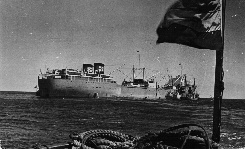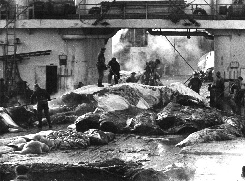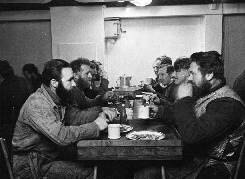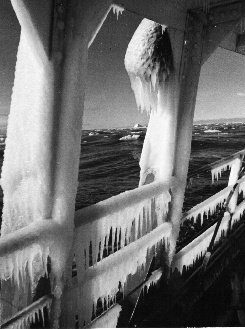 |
|||||||||||||||
|
|
|||||||||||||||
|
|||||||||||||||
|
The
Kosmos whaling fleet 1948/49 season
|
 |
|||||||||||||||
|
|
|||||||||||||||
|
|||||||||||||||
|
The
Kosmos whaling fleet 1948/49 season
|
|
Introduction The Kosmos whaling company was based in Sandefjord, Norway, and owned and managed by the Sandefjord ship owner Anders Jahre. This fleet was typical of all the Norwegian and British pelagic whaling fleets which voyaged the Antarctic waters in the years immediately preceding and following the Second World War. |
||||||||||||||||||||||||||||||||||||||||||||||||||||
|
The factory ship - Kosmos III The command centre of the fleet was the factory ship - in the case of the 1948/49 season this was Kosmos III (Though Kosmos IV joined the fleet later on).  The
factory ship was a large vessel, several hundred feet in length, with a
forward superstructure housing the bridge, communications centre and officers
accommodation, and amidships and aft superstructures housing deck crew
accommodation and deck plant rooms. Kosmos III made her first maiden voyage
in 1947, and was the most modern and best equipped whaling factory ship
of the era. The vessel was equipped with a slipway aft, which cut through
the below decks and the aft superstructure at an angle, from just below
the waterline, to the level of the main deck. With the aid of winches aft
of the forward superstructure and amidships, an entire whale could be hauled
up onto the deck for butchering. The main deck was large enough to accommodate
several whales at a time. During the 1948/49 season, it was not uncommon
for the butchering crew to butcher up to five whales a day. The
factory ship was a large vessel, several hundred feet in length, with a
forward superstructure housing the bridge, communications centre and officers
accommodation, and amidships and aft superstructures housing deck crew
accommodation and deck plant rooms. Kosmos III made her first maiden voyage
in 1947, and was the most modern and best equipped whaling factory ship
of the era. The vessel was equipped with a slipway aft, which cut through
the below decks and the aft superstructure at an angle, from just below
the waterline, to the level of the main deck. With the aid of winches aft
of the forward superstructure and amidships, an entire whale could be hauled
up onto the deck for butchering. The main deck was large enough to accommodate
several whales at a time. During the 1948/49 season, it was not uncommon
for the butchering crew to butcher up to five whales a day. |
||||||||||||||||||||||||||||||||||||||||||||||||||||
 The
butchering process involved removing the blubber from the whale, and cutting
it into manageable sizes which could be dropped through a hatch in the
deck, into the rendering area below. Here the blubber went into large tryworks
- which on Kosmos III were fuelled by diesel. The blubber would be melted
and rendered to oil, which would be stored in large holding tanks. Some
of the meat was also processed as meat-extract for animal feed or agricultural
fertiliser. But whale meat was a by-product on such voyages, one which
was often simply thrown overboard. The
butchering process involved removing the blubber from the whale, and cutting
it into manageable sizes which could be dropped through a hatch in the
deck, into the rendering area below. Here the blubber went into large tryworks
- which on Kosmos III were fuelled by diesel. The blubber would be melted
and rendered to oil, which would be stored in large holding tanks. Some
of the meat was also processed as meat-extract for animal feed or agricultural
fertiliser. But whale meat was a by-product on such voyages, one which
was often simply thrown overboard. |
||||||||||||||||||||||||||||||||||||||||||||||||||||
|
Certain internal organs such as the liver were rich in oils which were rendered separately. The sperm whale was a prized catch, supplying valuable spermaceti - a waxy oil in the head of the whale which was rendered separately and used for candle production and various industrial processes. |
||||||||||||||||||||||||||||||||||||||||||||||||||||
 Some
organs - such as the intestines would be processed as animal fodder, though
usually these were discarded. The butchering process was essentially manual,
the crew of 400 working two 12 hour shifts. It was hard work, using flensing
tools and long knives the meat and blubber would be separated from the
carcass. Winches would be used to pull large strips of blubber or meat
away from the carcass, whilst the crew worked with their flensing tools.
The deck was also equipped with large mechanical grabs which allowed parts
of the carcass to be ripped apart and manoeuvred about the deck area. The
entire deck area was covered in timber - a new deck laid for each voyage
- to protect the flensing tools - and the steel deck underneath from damage
during the butchering process. Each season, during the voyage home to Norway,
the crew would rip up the deck and throw the old planks overboard, and
replace the decking with new timbers before the next season. Some
organs - such as the intestines would be processed as animal fodder, though
usually these were discarded. The butchering process was essentially manual,
the crew of 400 working two 12 hour shifts. It was hard work, using flensing
tools and long knives the meat and blubber would be separated from the
carcass. Winches would be used to pull large strips of blubber or meat
away from the carcass, whilst the crew worked with their flensing tools.
The deck was also equipped with large mechanical grabs which allowed parts
of the carcass to be ripped apart and manoeuvred about the deck area. The
entire deck area was covered in timber - a new deck laid for each voyage
- to protect the flensing tools - and the steel deck underneath from damage
during the butchering process. Each season, during the voyage home to Norway,
the crew would rip up the deck and throw the old planks overboard, and
replace the decking with new timbers before the next season. |
||||||||||||||||||||||||||||||||||||||||||||||||||||
 Kosmos
III was a modern whaling vessel in 1948, having completed her maiden voyage
the previous year. It was a floating community, home for some 400 men,
with all the necessary facilities for eight months at sea. Below decks,
there was a pig sty with space for 100 pigs, which would be fattened and
slaughtered at sea to provide food for the crew. There was a complete metalwork
shop where deck tools were made and repaired, as well as a fully equipped
hospital and operating theatre - a grim necessity in case of injuries from
the work on deck. In the days before communications satellites , the fleet
relied on short-wave radiotelegraphy - mainly morse code, to keep in touch
with home and return their weekly harvest reports. The Norwegian radio
broadcast a daily news summary in Norwegian, which was typed up and circulated
amongst the crew. Kosmos
III was a modern whaling vessel in 1948, having completed her maiden voyage
the previous year. It was a floating community, home for some 400 men,
with all the necessary facilities for eight months at sea. Below decks,
there was a pig sty with space for 100 pigs, which would be fattened and
slaughtered at sea to provide food for the crew. There was a complete metalwork
shop where deck tools were made and repaired, as well as a fully equipped
hospital and operating theatre - a grim necessity in case of injuries from
the work on deck. In the days before communications satellites , the fleet
relied on short-wave radiotelegraphy - mainly morse code, to keep in touch
with home and return their weekly harvest reports. The Norwegian radio
broadcast a daily news summary in Norwegian, which was typed up and circulated
amongst the crew. |
||||||||||||||||||||||||||||||||||||||||||||||||||||
 The
harpoon vessels The
harpoon vessels
Kosmos III was kept busy by a fleet of 10 harpoon vessels - smaller craft which were equipped with a harpoon cannon on the bow. These small vessels, each with a crew of about 20 men, plied the whaling grounds in search of whales. Whilst most vessels hunted, some would be on standby - to undertake repairs, or to act as buoy-vessels which would look after the whales which the other ships had killed, until these were towed to the factory ship. |
||||||||||||||||||||||||||||||||||||||||||||||||||||
 When
a whale was killed, the crew would move alongside the whale and set a float
onto the whale to mark its position. Some whales float naturally when they
are killed, whilst others take in water and sink. The harpoon vessels were
equipped with compressors, which could be used to pump air into the whale's
abdominal cavity thus inflating the whale to keep it afloat. The venting
of this air could be an unpleasant process for the butchering crew. A heavy
rope would also be attached to the fluke of the whale, so that it could
be tied off to the ship. When one of the harpoon vessels had enough whales
- supplemented by the catch from other vessels in the fleet, it would sail
to the factory ship, often with 3 or 4 whales tied along each side of the
vessel. When
a whale was killed, the crew would move alongside the whale and set a float
onto the whale to mark its position. Some whales float naturally when they
are killed, whilst others take in water and sink. The harpoon vessels were
equipped with compressors, which could be used to pump air into the whale's
abdominal cavity thus inflating the whale to keep it afloat. The venting
of this air could be an unpleasant process for the butchering crew. A heavy
rope would also be attached to the fluke of the whale, so that it could
be tied off to the ship. When one of the harpoon vessels had enough whales
- supplemented by the catch from other vessels in the fleet, it would sail
to the factory ship, often with 3 or 4 whales tied along each side of the
vessel. |
||||||||||||||||||||||||||||||||||||||||||||||||||||
|
Most of the harpoon vessel crew were hired for that particular vessel, though often they were moved from vessel to vessel to keep the fleet manned as best as possible. Thousands of miles away from home, replacement crew members to cover sickness or injuries were impossible to come by.  This was particularly the case for the harpooners - who were the very elite
of the fleet. For the crew of the harpoon ships, a good harpooner was worth
his weight in gold, as the entire crew was paid according to a complicated
system whereby each man received a share in the value of the harvest. Sometimes
a harpooner would be injured or fall sick, in which case another crewman
would be appointed to fill in for him - usually after a long discussion
amongst the crew, whose earnings were dependent on the skill of the harpooner.
During the 1948/49 season, several harpooners were transferred from one
harpoon vessel to another.
This was particularly the case for the harpooners - who were the very elite
of the fleet. For the crew of the harpoon ships, a good harpooner was worth
his weight in gold, as the entire crew was paid according to a complicated
system whereby each man received a share in the value of the harvest. Sometimes
a harpooner would be injured or fall sick, in which case another crewman
would be appointed to fill in for him - usually after a long discussion
amongst the crew, whose earnings were dependent on the skill of the harpooner.
During the 1948/49 season, several harpooners were transferred from one
harpoon vessel to another. |
||||||||||||||||||||||||||||||||||||||||||||||||||||
 Life
at sea in the whaling fleet was extremely hard. The Antarctic weather was
extremely cold, especially at the start and end of the season. Storms were
frequently encountered, bringing their own special dangers - particularly
over-icing - whereby the deck and superstructure would be quickly covered
with near frozen sea water, which would turn to ice upon hitting the cold
steel. Such a vessel could quickly become unstable, unless the all hands
went on deck and broke of the ice with wooden mallets and shovels. The
risk of capsizing in the frozen Antarctic waters, possibly hundreds of
miles from the nearest help was to be avoided at all cost. Maritime clothing
was not what it is today, everything became waterlogged quickly, and even
fur and sealskin clothing was heavy to wear and prone to becoming waterlogged
and frozen stiff. Life
at sea in the whaling fleet was extremely hard. The Antarctic weather was
extremely cold, especially at the start and end of the season. Storms were
frequently encountered, bringing their own special dangers - particularly
over-icing - whereby the deck and superstructure would be quickly covered
with near frozen sea water, which would turn to ice upon hitting the cold
steel. Such a vessel could quickly become unstable, unless the all hands
went on deck and broke of the ice with wooden mallets and shovels. The
risk of capsizing in the frozen Antarctic waters, possibly hundreds of
miles from the nearest help was to be avoided at all cost. Maritime clothing
was not what it is today, everything became waterlogged quickly, and even
fur and sealskin clothing was heavy to wear and prone to becoming waterlogged
and frozen stiff. |
||||||||||||||||||||||||||||||||||||||||||||||||||||
|
In the 1948/49 season, the Kosmos fleet was made up of the following vessels - |
||||||||||||||||||||||||||||||||||||||||||||||||||||
|
||||||||||||||||||||||||||||||||||||||||||||||||||||
|
|